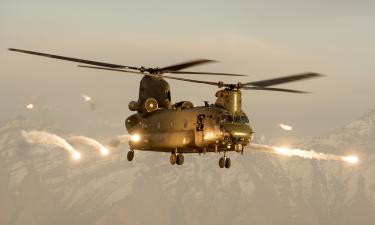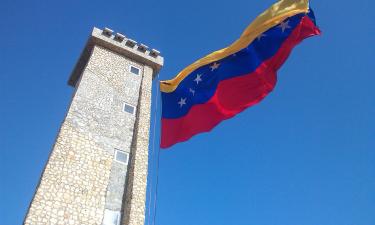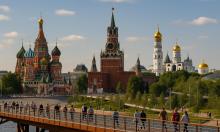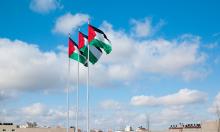The Unrecognized Tragedy of Serbian Krajina
August 7th marked 15 years since the destruction of the Republic of Serbian Krajina in Croatia by the Croatian army. Thousands of Serbs were killed, about 500,000 fled their homes. The West played its role in the tragedy of the Croatian Serbs too.

The situation in Croatia aggravated in 1990, during the presidency of Franjo Tudman, when the republic was a part of Yugoslavia. Tudman raised the subject of separating from Yugoslavia. The local parliament approved the new constitution in December 1990, where Croatia was declared a national state of the Croatian nation. The 700,000-strong Serbian nation made up 15 percent of the republic.
Referendums took place in several regions in the south and in the east of Croatia, where the Serbs were the majority. Three self-recognized Serbia autonomies appeared as a result of the vote. The territories had announced their decision to separate from Croatia by the summer of 1991.
Russia Today: UN membership door closed for Kosovo
On the one hand, the Croatians had their own state 1,000 years ago. Their republic was quite a wealthy one judging upon the general standards of Yugoslavia. The funds of Croatian tax payers were transferred to such poor regions as Kosovo, Macedonia and Bosnia. The separatist sentiments among the Croats were growing - they were not happy that they had to maintain other peoples.
On the other hand, the Serbs had been living in Croatia for hundreds of years and also "had a right for something." They were not willing to lose their ties with the ethnic motherland to be turned into a national minority. Then-president of Serbia Slobodan Milosevic promised not to leave his people in trouble. The Croatian Serbs hoped that Belgrade would help them.
The parliament of Croatia announced the decision to separate from Yugoslavia on June 25, 1991. The Serbs did not welcome such a move. Their self-recognized autonomies in the east and the south of Croatia united into the Republic of Serbian Krajina at the end of 1991. The new formation made a decision to separate from Croatia.
Numerous armed clashes took place throughout a half of the Croatian territory in the summer of 1991. The Croatian military men left the Yugoslavian people's army and formed the core of the national army.
All attempts to find points of contact between the Croats and the Serbs failed. The two peoples were fighting for one and the same territories, which determined the fierce character of the war during 1991-1995. Both the Croats and the Serbs were brutally exterminating "others", they hardly ever took prisoners of war.
A hope for the better appeared in December of 1992, when the government of Croatia offered to establish two autonomous Serbian regions in the country. The authorities of the Serbian Krajina declined.
The UN, the EU and a number of Western countries began to get involved in what was happening in Croatia. The USA and Europe took the side of Croatia unanimously. They recognized Croatia's independence, but refused to do the same for the Serbian Krajina. UN servicemen appeared in the region in January 1992, but it did not stop the bloodshed.
The international reaction was different. The Hague Tribunal was dealing with the Serbs, and the Western media were indulging in the stories about their crimes, but they preferred not to report much about the actions of the Croats. For example, UN observers prepared a report about the Croats' crimes in the town of Medak in the fall of 1993, but The Hague has not given it a consideration still.
The Croats gradually reached a military predominance. Despite the UN embargo on arms shipment to the former Yugoslavia, they were receiving state-of-the-art military hardware from the West. The USA and Croatia signed an agreement on military cooperation in November 1994. The Serbian Krajina was suffering from a serious lack of weaponry and ammunition.
Things changed in 1995. The Croatian army conducted a special operation and occupiedtheterritoryknownasWesternSlavonia. UN military men were openly inactive. The US Secretary of State Warren Christopher and Germany's Foreign Secretary Klaus Kinkel gave Croatia a permission in June to conduct another operation, which began on August 4, 1995.
The 70,000-strong Croatian army attacked the 15,000-strong army of the Serbian Krajina with its outdated military hardware. The Croats were conducting the operation with the help of the NATO aviation. The UN forces were simply watching the Croatian army burning dozens of Serbian villages. Croats announced the liquidation of the self-recognized republic of the Serbian Krajina on August 7.
The West was simply turning a blind eye on the atrocities committed by the Croatians. The USA and the EU hurried to recognize Croatia as a socialist republic. The Serbs received no autonomy whatsoever.
Who is going to be responsible for the fact that 500,000 Serbs were forced to flee their homes? The Hague Tribunal did take some efforts targeting Croatian military leaders, but the process is very slow and it does not receive any coverage in the media. President Tudman and Janko Bobetko, a general of the Croatian army, who ordered to launch Operation Storm, died natural deaths in 1991 and 2003 respectively.
The Serbs received the maximum punishment. Milan Babic, the first president of the Serbian Krajina, was sentenced to 13 years in jail, where he subsequently committed suicide. His successor Goran Gajic is on international wanted list. The last leader of the Croatian Serbs, Milan Martic, is serving his 35 years in jail.
Russian historian Vladimir Putyatin said in an interview with Pravda.Ru that the Western countries played perhaps the most important role in the defeat of the Croatian Serbs.
"The USA and Germany were unwilling to solve the conflict peacefully. They did not want to grant autonomy to the Serbian Krajina, but simply took the side of Zagreb. There is a feeling that the collapse of Krajina became the first stage in the plan of the West to destroy the Serbian state structure by ousting the Serbs from the territories of their living.
"The second stage took place in Bosnia and Herzegovina, where the Serbs were not allowed to unite with Serbia. Then there was Kosovo. There is no guarantee that it will soon be the turn for multinational regions of Serbia - Sandzac and Vojvodina. As a result, the Serbs will be left only with a half of contemporary Serbia - like it was during the 19th century," the scientist said.
Vadim Prozorov, another historian, believes that there are many people guilty of that tragedy.
"First and foremost, they are the leaders of Serbia and Croatia of those times - Slobodan Milosevic and Franjo Tudman. The authorities of Krajina were guilty too. They were deeply involved in their own squabbles and did not even think of how their republic could exist. There were no resources, no industry, no employment. The Serbian Krajina could not exist independently. The Western leaders are also guilty of what had happened. They could stop the massacre, but preferred to encourage it instead.
There are just a few Serbs left in Croatia today. No one infringes upon their rights, there is no legal persecution against them either. There are Serbian deputies in the Croatian parliament. But no one is going to grant them autonomy. Four percent of the population is not fifteen percent like it was before the war.
"We would like to hope that The Hague Tribunal will complete the trials over the Croatian generals, who commanded the destruction of Krajina. There are no reasons to believe that The Hague is covering them up. But they are the people who fulfilled orders, one should not blame them for everything. It is the political leaders of Croatia that should have been put on trial in the first place," the historian said.
Vadim Trukhachev
Pravda.Ru
Subscribe to Pravda.Ru Telegram channel, Facebook, RSS!




